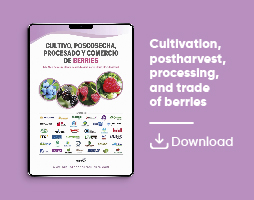Actualidad
State of the art of sensors used in postharvest technologies
These developments are poised to transform existing practices, particularly in quality and safety monitoring.
Redaccion
Patent portfolio management, patent strategy, and patent analysis are important topics for both industry and research. In industry, companies use patent portfolio management to protect their intellectual property and gain a competitive advantage.
A well-managed patent portfolio can help companies defend against infringement, negotiate licensing agreements, and generate revenue through the sale or licensing of patents. By disclosing an invention, a patent inventor enables its incorporation into future creations.
Analysis of patent portfolios
Advancements in patent management, analysis, and strategy have led to the development of best practices and analytical tools for handling patent portfolios. Managing large patent databases manually, relying on common sense, can be challenging and may lead to biased results influenced by expert assumptions.
However, objective exploration of technology trends based on patent data is achievable through methods like topic modeling, which uses hierarchical probabilistic models to uncover and classify patterns of words within patent portfolios (Suominen et al., 2017).
The analysis of patent portfolios as a tool for identification of trends has already been performed in many emerging technological fields (Li et al., 2020), such as new space missions (Garzaniti et al., 2021), fuel cell vehicles (Shi et al., 2019) and application of blockchain technologies in the food supply chain (Mastilovi? et al., 2023).
This approach was already applied in the field of postharvest technologies, such as the identification of trends in fresh mushrooms postharvest technologies (Choi et al., 2020a), postharvest management of fresh agriculture products (Choi et al., 2020b), postharvest packaging and storage technology (Choi et al., 2021), and development of nano-sensors (Ki and Kim, 2017).
Real-time monitoring
Automated real-time monitoring of relevant parameters through sensing technologies is a rapidly developing field of science and technology that holds great importance and widespread application in the postharvest handling of fresh produce.
In fresh produce supply chains utilization of sensing technologies results in obtaining datasets enabling introduction of artificial intelligence and machine learning-based decision-making.
The combination of sensing technologies and data modelling contributes to the further increase of shelf life, quality and safety of the products and the automation of support processes (He et al., 2023).
Development of sensing tools such as imaging technology, spectroscopy, electronic nose, radio frequency identification, acoustic impulse response together with mathematical modeling, Internet of Things (IoT), digital twins and a variety of biosensors and multi-sensors is permanently progressing.
Sensors in postharvest supply chains
The application of sensors in postharvest supply chains has been widely studied. Sensors are implemented to support the monitoring, diagnosis and mitigation of potential problems affecting the quality of fresh produce (Onwude et al., 2020).
Sensors have been developed also for a variety of other parameters relevant to fresh produce after harvest, including those for gas composition (Jochum et al., 2016), including ethylene (Hu et al., 2019), pesticide residues (Motol et al., 2020), volatile compounds analysis (Tiwari et al., 2020), assessment of mechanical damages (Bollen, 2006), determination of firmness (De Ketelaere et al., 2006), multivariate evaluation of fresh produce quality assessment (Saeys et al., 2019) and other emerging applications.
Trends in the field of application of sensors
The aim of this study was to provide insight into trends in the field of application of sensors in fresh produce postharvest through the extraction of a related patent portfolio, its analysis and discussion in relation to the developments reported in academic literature followed by an assessment of topic development trends.
Abstract
The objective of the present study was to provide insight into trends of sensors in postharvest of fresh produce. Patent portfolio of 881 patents obtained through a multistep refinement of the PatSnap patent database was analyzed. Intensive patenting activities started in 2014 with most patents originating from Asia, with China as the leading patenting authority.
Latent Dirichlet Allocation topic modelling differentiated existence of three distinct topics, out of which two are related to the application of sensors in
- (A) produce sorting and packaging along with related processes, and
- (B) produce storage, respectively.
The third topic is related to the development and application of a diversity of sensors for analysis of the fresh produce and storage environment, as well as solutions for the application of sensors in monitoring, data collection and development of prediction models.
The analysis of patent portfolio and trends highlights the ongoing and rapid advancement of sensing technologies in fresh produce postharvest, which has a substantial impact on the landscape of postharvest processes.
Our findings indicate that these developments are poised to transform existing practices, particularly in quality and safety monitoring.
Additionally, they are expected to provide comprehensive datasets that can support the broader integration of artificial intelligence into postharvest processes, ultimately leading to more coherent and efficient supply chains.
Sources
Sensors in postharvest technologies: Evidence from patent portfolio analysis
Jasna Mastilovi?, ?arko Kevre?an, Dragan Kukolj, Renata Kova?, Dragana Ubiparip Samek, Stevan Stankovski, Gordana Ostoji & Marina ?eri Postharvest Biology and Technology, Volume 208, February 2024, 112628https://doi.org/10.1016/j.postharvbio.2023.112628https://www.sciencedirect.com/science/article/abs/pii/S0925521423003897
Figure is by TOMRA, https://www.tomra.com/en/waste-metal-recycling/products/technologies/flying-beam









